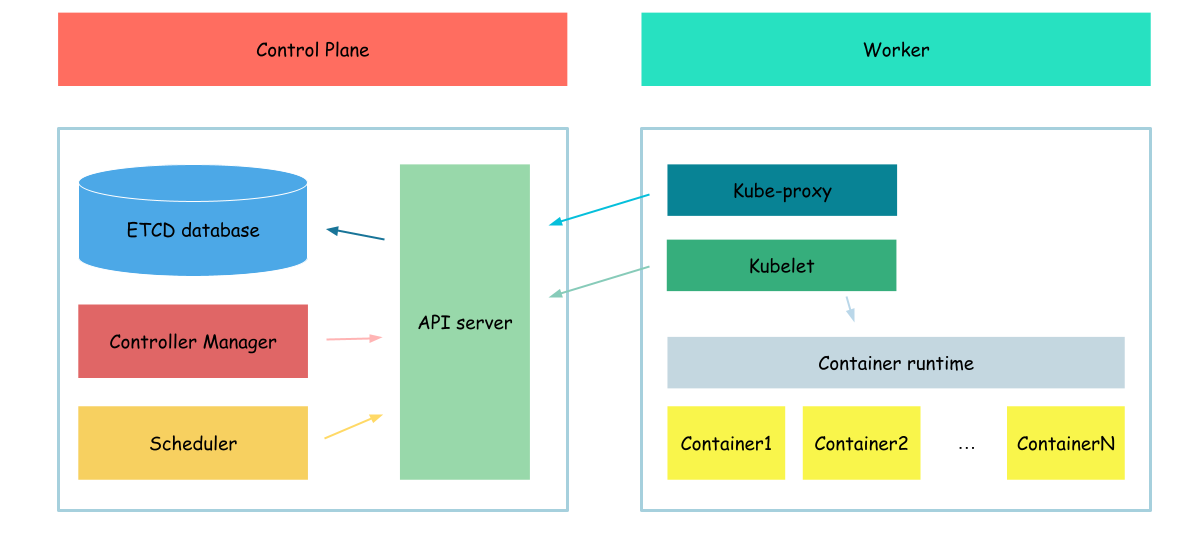8.0 KiB
Kube-proxy
In this section we will configure kupe-proxy.
kube-proxy is a network proxy that runs on each node in your cluster, implementing part of the Kubernetes Service concept. kube-proxy maintains network rules on nodes. These network rules allow network communication to your Pods from network sessions inside or outside of your cluster.
Before we will start, lets clarify the reason why do we need it. To do that, we will create deployment with nginx.
{
cat <<EOF | tee nginx-deployment.yml
apiVersion: v1
kind: ConfigMap
metadata:
name: nginx-conf
data:
default.conf: |
server {
listen 80;
server_name _;
location / {
return 200 "Hello from pod: \$hostname\n";
}
}
---
apiVersion: apps/v1
kind: Deployment
metadata:
name: nginx-deployment
spec:
selector:
matchLabels:
app: nginx
replicas: 3
template:
metadata:
labels:
app: nginx
spec:
containers:
- name: nginx
image: nginx:1.21.3
ports:
- containerPort: 80
volumeMounts:
- name: nginx-conf
mountPath: /etc/nginx/conf.d
volumes:
- name: nginx-conf
configMap:
name: nginx-conf
EOF
kubectl apply -f nginx-deployment.yml
}
kubectl get pod -o wide
Output:
NAME READY STATUS RESTARTS AGE IP NODE NOMINATED NODE READINESS GATES
nginx-deployment-db9778f94-2zv7x 1/1 Running 0 63s 10.240.1.12 example-server <none> <none>
nginx-deployment-db9778f94-q5jx4 1/1 Running 0 63s 10.240.1.10 example-server <none> <none>
nginx-deployment-db9778f94-twx78 1/1 Running 0 63s 10.240.1.11 example-server <none> <none>
As you an see, we created 3 pods (each has its own ip address). Now, we will run busybox container and will try to access our pods from other container
{
cat <<EOF | tee pod.yaml
apiVersion: v1
kind: Pod
metadata:
name: busy-box
spec:
containers:
- name: busy-box
image: busybox
command: ['sh', '-c', 'while true; do echo "Busy"; sleep 1; done']
EOF
kubectl apply -f pod.yaml
}
And execute command from our container
kubectl exec busy-box -- wget -O - $(kubectl get pod -o wide | grep nginx | awk '{print $6}' | head -n 1)
Output:
Hello from pod: nginx-deployment-68b9c94586-qkwjc
Connecting to 10.32.0.230 (10.32.0.230:80)
writing to stdout
- 100% |********************************| 50 0:00:00 ETA
written to stdout
Note: usually, it takes some time to apply all RBAC policies
Note: it take some time to apply user permission. During this you can steel see permission error.
As you can see, we successfully received the response from the nginx. But to do that we used the IP address of the pod. To solve service discovery issue, kubernetes has special component - service. Now we will create it.
{
cat <<EOF | tee nginx-service.yml
apiVersion: v1
kind: Service
metadata:
name: nginx-service
spec:
selector:
app: nginx
ports:
- protocol: TCP
port: 80
targetPort: 80
EOF
kubectl apply -f nginx-service.yml
}
Get service created
kubectl get service
Now, we will try to access our pods by using the IP of the service created.
kubectl exec busy-box -- wget -O - $(kubectl get service -o wide | grep nginx | awk '{print $3}')
Output:
Connecting to 10.32.0.230 (10.32.0.230:80)
As you can see, we received an error. This error occured because kubernetes know nothing about the IP creted for the service. As already mentioned, kube-proxy is the component responsible to handle requests to ip of the service and redirect that requests to the pods. So, lets configure kube-proxy.
certificates
We will start with certificates.
As you remeber we configured our API server to use client certificate to authenticate user. So, lets create proper certificate for the kube-proxy
{
cat <<EOF | tee kube-proxy-csr.json
{
"CN": "system:kube-proxy",
"key": {
"algo": "rsa",
"size": 2048
},
"names": [
{
"C": "US",
"L": "Portland",
"O": "system:node-proxier",
"OU": "Kubernetes The Hard Way",
"ST": "Oregon"
}
]
}
EOF
cfssl gencert \
-ca=ca.pem \
-ca-key=ca-key.pem \
-config=ca-config.json \
-profile=kubernetes \
kube-proxy-csr.json | cfssljson -bare kube-proxy
}
The most interesting configuration options:
- cn(common name) - value, api server will use as a client name during authorization
- o(organozation) - user group system:node-proxier will use during authorization
We specified "system:node-proxier" in the organization. It says api server that the client who uses which certificate belongs to the system:node-proxier group.
configuration
After the certificate files created we can create configuration files for the kube proxy.
{
kubectl config set-cluster kubernetes-the-hard-way \
--certificate-authority=ca.pem \
--embed-certs=true \
--server=https://127.0.0.1:6443 \
--kubeconfig=kube-proxy.kubeconfig
kubectl config set-credentials system:kube-proxy \
--client-certificate=kube-proxy.pem \
--client-key=kube-proxy-key.pem \
--embed-certs=true \
--kubeconfig=kube-proxy.kubeconfig
kubectl config set-context default \
--cluster=kubernetes-the-hard-way \
--user=system:kube-proxy \
--kubeconfig=kube-proxy.kubeconfig
kubectl config use-context default --kubeconfig=kube-proxy.kubeconfig
}
We created kubernetes configuration file, which says kube-proxy where api server is configured and which certificates to use communicating with it
Now, we can distribute created configuration file.
mkdir -p /var/lib/kube-proxy \
&& mv kube-proxy.kubeconfig /var/lib/kube-proxy/kubeconfig
After all required configuration file created, we need to download kube-proxy binaries.
wget -q --show-progress --https-only --timestamping \
https://dl.k8s.io/v1.32.3/bin/linux/amd64/kube-proxy
And install it
chmod +x kube-proxy \
&& mv kube-proxy /usr/local/bin/
Now, we can create configuration file for kube-proxy
cat <<EOF | tee /var/lib/kube-proxy/kube-proxy-config.yaml
kind: KubeProxyConfiguration
apiVersion: kubeproxy.config.k8s.io/v1alpha1
clientConnection:
kubeconfig: "/var/lib/kube-proxy/kubeconfig"
mode: "iptables"
clusterCIDR: "10.200.0.0/16"
EOF
Service configuration file
cat <<EOF | tee /etc/systemd/system/kube-proxy.service
[Unit]
Description=Kubernetes Kube Proxy
Documentation=https://github.com/kubernetes/kubernetes
[Service]
ExecStart=/usr/local/bin/kube-proxy \\
--config=/var/lib/kube-proxy/kube-proxy-config.yaml
Restart=on-failure
RestartSec=5
[Install]
WantedBy=multi-user.target
EOF
Start service
systemctl daemon-reload \
&& systemctl enable kube-proxy \
&& systemctl start kube-proxy
And check its status
systemctl status kube-proxy
Output:
● kube-proxy.service - Kubernetes Kube Proxy
Loaded: loaded (/etc/systemd/system/kube-proxy.service; enabled; vendor preset: enabled)
Active: active (running) since Thu 2023-04-20 13:37:27 UTC; 23s ago
Docs: https://github.com/kubernetes/kubernetes
Main PID: 19873 (kube-proxy)
Tasks: 5 (limit: 2275)
Memory: 10.0M
CGroup: /system.slice/kube-proxy.service
└─19873 /usr/local/bin/kube-proxy --config=/var/lib/kube-proxy/kube-proxy-config.yaml
...
verification
After we configured kube-proxy, we can check how or service works once again.
kubectl exec busy-box -- wget -O - $(kubectl get service -o wide | grep nginx | awk '{print $3}')
Output:
Hello from pod: nginx-deployment-68b9c94586-qkwjc
Connecting to 10.32.0.230 (10.32.0.230:80)
writing to stdout
- 100% |********************************| 50 0:00:00 ETA
written to stdout
If you try to repeat the command once again you will see that requests are handled by different pods.
